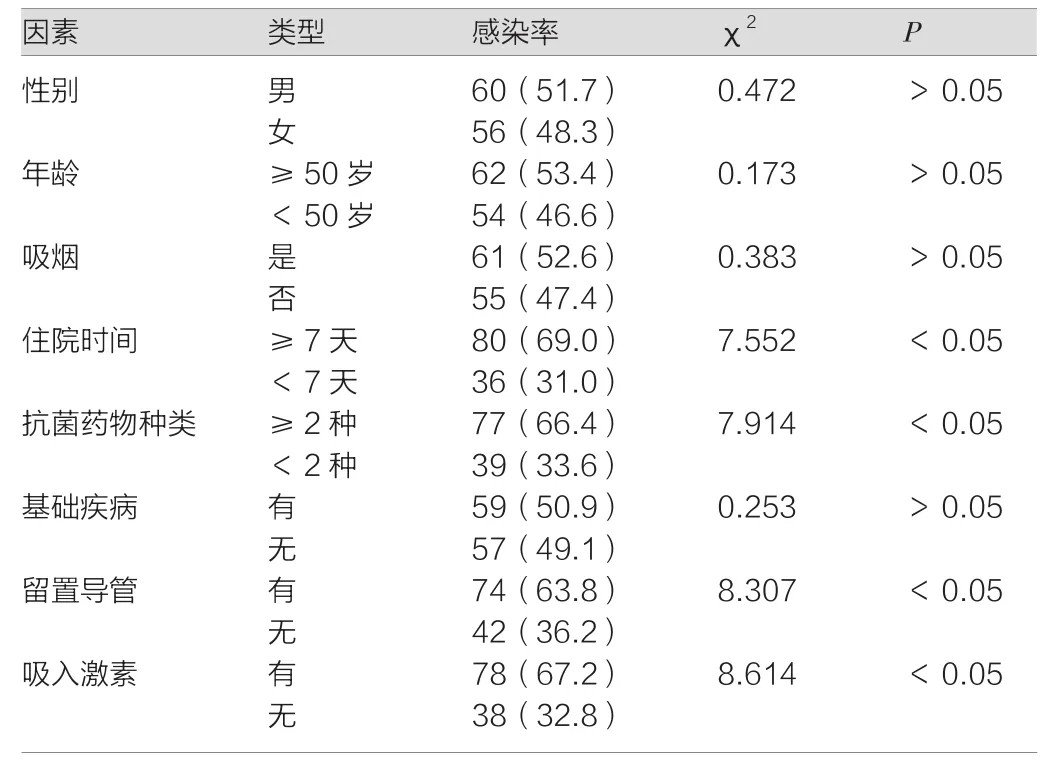慢性阻塞性肺疾病患者医院感染特征及危险因素分析
2016-06-12宋巍
宋 巍
慢性阻塞性肺疾病患者医院感染特征及危险因素分析
宋巍
【摘要】目的 探讨慢性阻塞性肺疾病患者医院感染的临床特征和危险因素,为临床预防慢性阻塞性肺疾病患者医院感染提供参考依据。方法 采取回顾性方法对医院2012年6月~2015年6月380例慢性阻塞性肺疾病患者的临床资料进行分析,观察其医院感染的情况,并应用SPSS19.0统计学软件进行分析感染的危险因素。结果 380例慢性阻塞性肺疾病患者中116例发生医院感染,感染发生率30.5%。感染中主要以呼吸道、泌尿道和消化道以及血流感染为主,比例为61.2%、17.3%、12.9%、8.6%。感染病原菌主要为革兰阴性菌71.4%,革兰阳性菌15.7%,真菌12.9%。住院时间≥7天、抗菌药物种类≥2种、留置导管和激素吸入治疗中出现医院感染率高于住院时间<7天、抗菌药物种类<2种、无留置导管和无激素吸入治疗中的感染率,数据差异有统计学意义(P<0.05)。住院时间、留置导管和抗菌药物种类以及吸入激素均是影响慢性阻塞性肺疾病患者医院感染的独立危险因素。结论 临床中慢性阻塞性肺疾病患者出现医院感染的病原菌主要以革兰阴性菌为主,且住院时间和留置导管以及抗菌药物种类与吸入激素均是导致慢性阻塞性肺疾病患者出现医院感染的危险因素,临床中应依据感染因素制定针对性的控制措施,降低感染。
【关键词】慢性阻塞性肺疾病;医院感染;临床特征;危险因素
作者单位:平煤神马医疗集团总医院感染科,河南 遂平 535000
慢性阻塞性肺疾病是临床中常见的呼吸道疾病,在临床中具有较高的发病率,对患者的身体健康和生活质量具有严重的影响[1]。由于慢性阻塞性肺疾病患者经常伴随着不同炎症的侵袭,很容易受到医院内的病原菌感染,从而引发医院感染,会进一步增加患者的住院时间和治疗成本,甚至危及其生命[2]。临床中积极地了解慢性阻塞性肺疾病患者医院感染的临床特征和危险因素对降低医院感染和治疗该病具有重要的临床应用价值[3]。本次研究采取回顾性方法对医院慢性阻塞性肺疾病患者的临床资料进行分析,旨在更好的了解其感染的临床特征和危险因素,具体的分析如下。
1 资料与方法
1.1一般资料
选取医院2012年6月~2015年6月380例慢性阻塞性肺疾病患者,且患者的资料完整,男性患者205例,女性患者175例。患者年龄为36~79岁,平均(50.2±6.3)岁。
1.2诊断标准
慢性阻塞性肺疾病诊断标准:依据中华医学会呼吸病学会所制定的《慢阻肺诊断标准》(2002年)中关于慢性阻塞性肺疾病的诊断标准。
医院感染诊断标准:依据国家卫生部制定的《医院感染诊断标准》的标准。
1.3研究方法
采取回顾性的分析方法进行对患者的临床资料分析,包括患者基本资料和感染的部位和病原菌以及感染的相关因素。
1.4统计学处理
应用SPSS 19.0统计学软件进行数据的分析与处理,计数资料应用χ2检验,医院感染的多因素以Logistic回归性分析,以P<0.05为差异有统计学意义。
2 结果
2.1临床感染情况观察
通过对380例慢性阻塞性肺疾病患者的临床资料分析,116例发生医院感染,医院感染发生率30.5%。感染中主要以呼吸道、泌尿道和消化道以及血流感染为主,具体的分析见表1。

表1 116例慢性阻塞性肺疾病患者医院感染部位分布及构成比(n,%)
2.2感染病原菌观察
通过对116例医院感染的慢性阻塞性肺疾病患者进行细菌培养分析,共计培养出140株病原菌,革兰阴性菌71.4%,革兰阳性菌15.7%,真菌12.9%。具体的感染病原菌分布及构成见表2。

表2 140株感染病原菌分布及构成比(%)
2.3慢性阻塞性肺疾病患者医院感染单因素分析
不同性别、不同年龄和是否吸烟以及是否伴随基础疾病中出现的感染率比较差异无统计学意义(P>0.05);住院时间≥7天、抗菌药物种类≥2种、留置导管和激素吸入治疗中出现医院感染率明显的高于住院时间<7天、抗菌药物种类<2种、无留置导管和无激素吸入治疗中的感染率,数据差异有统计学意义(P <0.05)。见表3。

表3 116例医院感染的单因素分析
2.4慢性阻塞性肺疾病患者医院感染多因素分析
通过对慢性阻塞性肺疾病患者医院感染的多因素分析,住院时间、留置导管和抗菌药物种类以及吸入激素均是影响慢性阻塞性肺疾病患者医院感染的独立危险因素。数据分析见表4。

表4 慢性阻塞性肺疾病患者医院感染的多因素Logistic分析
3 讨论
慢性阻塞性肺疾病是临床中常见的疾病,具有较高的发病率与死亡率,且多数的患者为老年患者,且身体状况较差,并且免疫力也比较低,在临床治疗的过程中很容易导致病原菌的侵袭,引发医院感染[4-5]。因此,临床中如何更好的预防和治疗慢性阻塞性肺疾病患者医院感染在临床中具有重要的意义。
经过此次的临床研究分析,慢性阻塞性肺疾病患者医院感染率达到30.5%。由此说明,慢性阻塞性肺疾病患者在临床中很容易出现感染,也是医院感染的高危人群。临床中相关研究显示,医院感染中主要以呼吸道、泌尿道和消化道以及血流感染为主。这一结论与临床中研究报道相似,进一步说明呼吸道感染是医院感染的最主要特征[6-7]。临床中对于医院感染的治疗最佳方案是依据患者的感染病原菌进行合理选择抗菌药物,此次的研究显示,慢性阻塞性肺疾病医院感染患者感染的病原菌主要以革兰阴性菌为主,比例达71.4%,其次为革兰阳性菌和真菌感染。主要是由于革兰氏阴性菌对呼吸黏膜的定植性相对比较强,很容易引起呼吸系统的感染[8-9]。因此,临床中可以依据感染病原菌的特点进行合理的选择抗菌药物进行预防性与治疗医院感染。为了进一步了解慢性阻塞性肺疾病患者医院感染的情况,对感染的危险因素进行分析。数据显示,住院时间、留置导管和抗菌药物种类以及吸入激素均是影响慢性阻塞性肺疾病患者医院感染的独立危险因素。长期的住院治疗很容易引起患者病情的反复性发作,导致身体的免疫力降低,加之长期的住院很容易增加与病原菌的接触,增加感染的几率[10]。同时,治疗中留置导管很容易引起身体的应激性,且长期的留置导管会增加病原菌的感染,最终引起医院感染[11]。另外,临床中使用多种抗菌药物很容易出现耐药的情况,从而进一步增加感染的几率。长期的使用激素吸入治疗,会引起口咽部和食管部位的真菌感染,导致医院感染的几率增加。
综上,慢性阻塞性肺疾病患者在临床中很容易出现医院感染,且以呼吸道感染为主,感染病原菌以革兰阴性菌为主。其中,住院时间和留置导管以及抗菌药物种类与吸入激素均是导致慢性阻塞性肺疾病患者出现医院感染的危险因素,临床中应引起重视。
参考文献
[1]Evans RA,Dolmage TE,Mangovski-Alzamora S,et al. One-Legged Cycle Training for Chronic Obstructive Pulmonary Disease.A Pragmatic Study of Implementation to Pulmonary Rehabilitation[J].Ann Am Thorac Soc.,2015,12(10):1490-1497.
[2]Kostinov MP,Ryzhov AA,Magarshak OO,et al. The clinical aspects of efficiency of the prevention of pneumococcal infection with vaccines in chronic obstructive pulmonary disease patients living in the West Siberian Region[J]. Ter Arkh.,2014,86(3):28-33.
[3]Shukla SD,Sohal SS,O'Toole RF,et al. Platelet activating factor receptor: gateway for bacterial chronic airway infection in chronic obstructive pulmonary disease and potential therapeutic target[J].Expert Rev Respir Med.,2015,9(4):473-485.
[4]Kostinov MP,Zhestkov AV,Protasov AD,et al. New ideas on the therapeutic effect of a combination of vaccines against pneumococcal,Haemophilus influenzae type b infection,and influenza in patients with chronic obstructive pulmonary disease[J]. Ter Arkh.,2015,87 (3):17-22.
[5]Yayan J. No significant detectable anti-infection effects of aspirin and statins in chronic obstructive pulmonary disease[J]. Int J Med Sci.,2015,12(3):280-287.
[6]Wang F,Liu J,Zhang Y,et al. Association of Helicobacter pylori infection with chronic obstructive pulmonary disease and chronic bronchitis: a meta-analysis of 16 studies[J]. Infect Dis.(Lond),2015,47(9):597-603.
[7]刘曦,丁立,陈惠丽,等. 肺结核患者医院感染的病原学及相关危险因素分析[J]. 热带医学杂志,2015,15(2):221-223.
[8]Hsu AC,Starkey MR,Hanish I,et al. Targeting PI3K-p110α Suppresses Influenza Virus Infection in Chronic Obstructive Pulmonary Disease[J]. Am J Respir Crit Care Med.,2015,191(9):1012-1023.
[9]Miravitlles M,Anzueto A. Role of infection in exacerbations of chronic obstructive pulmonary disease[J]. Curr Opin Pulm Med.,2015,21(3):278-283.
[10]Li YY,Wang P,Wang RJ,et al. Acute exacerbation of chronic obstructive pulmonary disease among hospitalized patients caused by influenza virus infection[J]. Acta Virol.,2014,58(4):383-385.
[11]Clark TW,Medina MJ,Batham S,et al. Adults hospitalised with acute respiratory illness rarely have detectable bacteria in the absence of COPD or pneumonia; viral infection predominates in a large prospective UK sample[J]. J Infect.,2014,69(5):507-515.
Analysis of Nosocomial Infection Characteristics and Risk Factors in Patients With Chronic Obstructive Pulmonary Disease
SONG Wei Infectious Disease Department, Ping Coal Shenma Medical Group General Hospital, Suiping He’nan 535000, China
[Abstract]Objective To investigate the clinical characteristics and risk factors of nonsocial infection in patients with COPD, chronic obstructive pulmonary disease for clinical prevention of nonsocial infections provide a reference. Methods Dangerous taken retrospectively clinical data among hospitals from June 2012 to June 2015, 380 cases of COPD patients werebook=23,ebook=34analyzed, to observe the situation of their hospital infections and application SPSS19.0 statistical software for analysis of infection. Results 380 cases of COPD patients, 116 cases of nonsocial infection, infection rate 30.5%. Mainly in the upper respiratory tract infection, urinary tract and digestive tract and bloodstream infections mainly ratio was 61.2%, 17.3%, 12.9% and 8.6%. Pathogens mainly gram-negative bacteria 71.4%, 15.7% Grampositive bacteria, fungi 12.9%. Hospital stay≥7 days, species≥2 kinds of antibiotics, indwelling catheters and inhaled portico therapy appear hospital infection was significantly higher than the hospitalization time<7 days, antimicrobial drug classes<2 kinds, no suction catheter and hormone therapy. The infection rate data significantly (P<0.05). Hospitalization time, indwelling catheters and types of antibiotics and inhaled stereoscopic are independent risk factors for COPD patients with nonsocial infections affect. Conclusion The clinical COPD patients hospital Infection mainly gram-negative bacteria, and the length of stay and the type of catheter and antimicrobial agents and inhaled stereoscopic are the result of the risk factors of nonsocial infection in patients with COPD, the clinical It should be developed in accordance with infection control measures targeted factor,reduce infection.
[Key words]Chronic obstructive pulmonary disease, Hospital infection,Clinical features, Risk factors
【中图分类号】R563
【文献标识码】A
【文章编号】1674-9308(2016)12-0022-03
doi:10.3969/j.issn.1674-9308.2016.12.015
